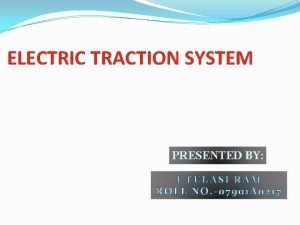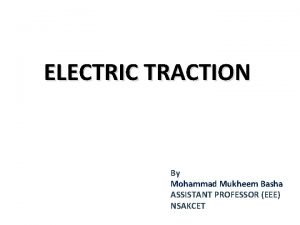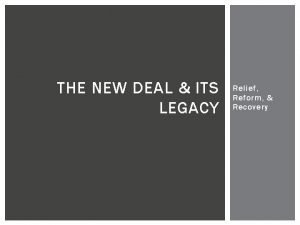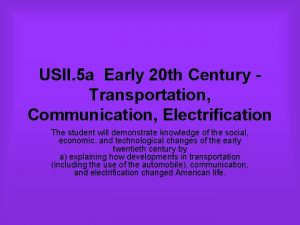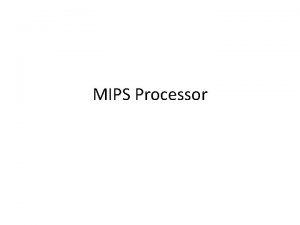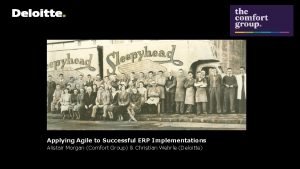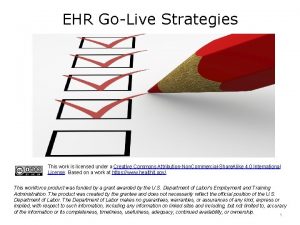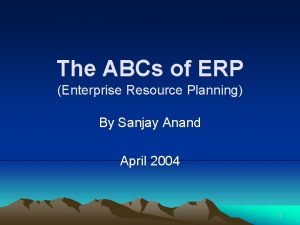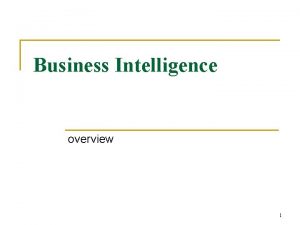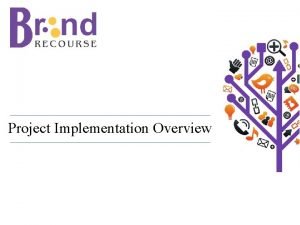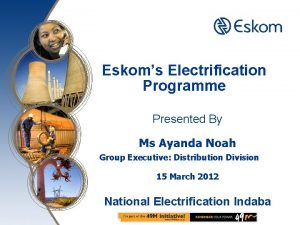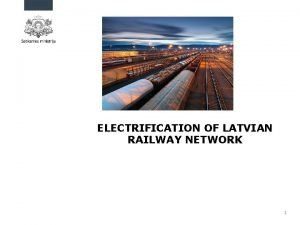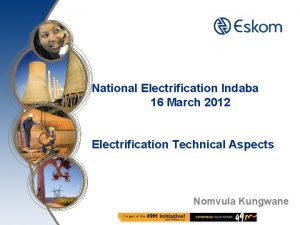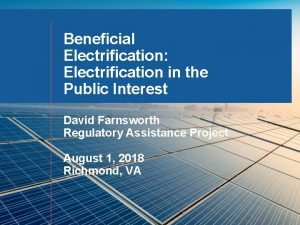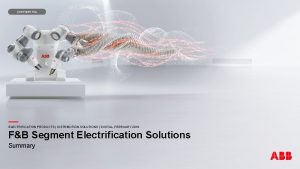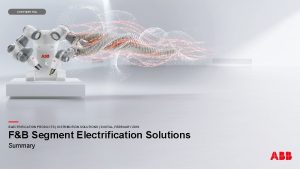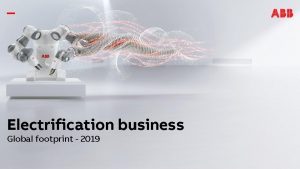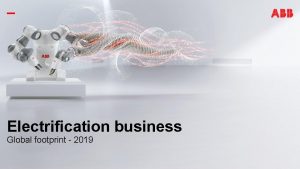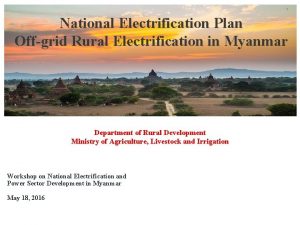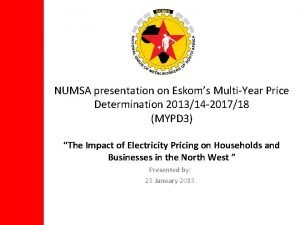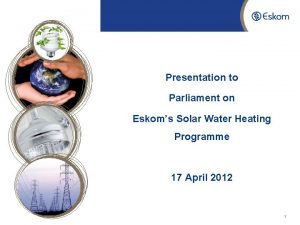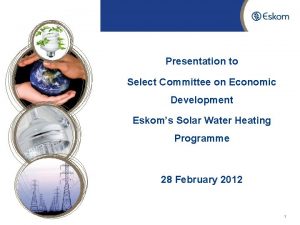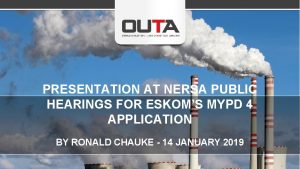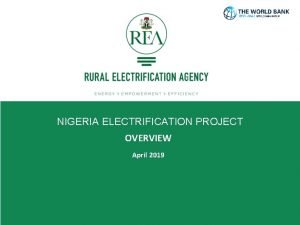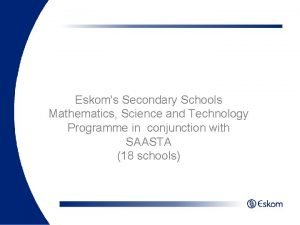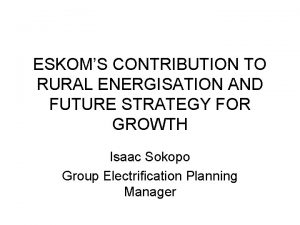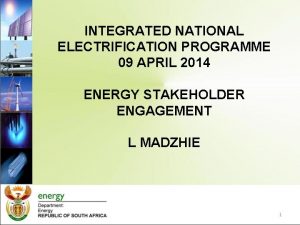Electrification An Integrated Implementation Approach Eskoms Overview Presentation
![Electrification: An Integrated Implementation Approach [Eskom’s Overview] Presentation to the Parliamentary Select Committee on Electrification: An Integrated Implementation Approach [Eskom’s Overview] Presentation to the Parliamentary Select Committee on](https://slidetodoc.com/presentation_image_h2/bc07bfd0ad3683b3262396822a813883/image-1.jpg)
![Contents 1. Brief Introduction/Background 2. Integrated National Electrification Programme [Eskom’s Area of Supply] 3. Contents 1. Brief Introduction/Background 2. Integrated National Electrification Programme [Eskom’s Area of Supply] 3.](https://slidetodoc.com/presentation_image_h2/bc07bfd0ad3683b3262396822a813883/image-2.jpg)




![Contents 1. Brief Introduction/Background 2. Integrated National Electrification Programme [Eskom’s Area of Supply] 3. Contents 1. Brief Introduction/Background 2. Integrated National Electrification Programme [Eskom’s Area of Supply] 3.](https://slidetodoc.com/presentation_image_h2/bc07bfd0ad3683b3262396822a813883/image-7.jpg)


![Contents 1. Brief Introduction/Background 2. Integrated National Electrification Programme [Eskom’s Area of Supply] 3. Contents 1. Brief Introduction/Background 2. Integrated National Electrification Programme [Eskom’s Area of Supply] 3.](https://slidetodoc.com/presentation_image_h2/bc07bfd0ad3683b3262396822a813883/image-10.jpg)


![Contents 1. Brief Introduction/Background 2. Integrated National Electrification Programme [Eskom’s Area of Supply] 3. Contents 1. Brief Introduction/Background 2. Integrated National Electrification Programme [Eskom’s Area of Supply] 3.](https://slidetodoc.com/presentation_image_h2/bc07bfd0ad3683b3262396822a813883/image-13.jpg)


![Contents 1. Brief Introduction/Background 2. Integrated National Electrification Programme [Eskom’s Area of Supply] 3. Contents 1. Brief Introduction/Background 2. Integrated National Electrification Programme [Eskom’s Area of Supply] 3.](https://slidetodoc.com/presentation_image_h2/bc07bfd0ad3683b3262396822a813883/image-16.jpg)





![Contents 1. Brief Introduction/Background 2. Integrated National Electrification Programme [Eskom’s Area of Supply] 3. Contents 1. Brief Introduction/Background 2. Integrated National Electrification Programme [Eskom’s Area of Supply] 3.](https://slidetodoc.com/presentation_image_h2/bc07bfd0ad3683b3262396822a813883/image-22.jpg)

![Funding Agreement Status [Status end of June 2006] n FBE Customers across 242 Municipalities Funding Agreement Status [Status end of June 2006] n FBE Customers across 242 Municipalities](https://slidetodoc.com/presentation_image_h2/bc07bfd0ad3683b3262396822a813883/image-24.jpg)
![FBE Status [Status end of June 2006] Municipalities FBE roll out Actual 222 Customers FBE Status [Status end of June 2006] Municipalities FBE roll out Actual 222 Customers](https://slidetodoc.com/presentation_image_h2/bc07bfd0ad3683b3262396822a813883/image-25.jpg)




- Slides: 29
![Electrification An Integrated Implementation Approach Eskoms Overview Presentation to the Parliamentary Select Committee on Electrification: An Integrated Implementation Approach [Eskom’s Overview] Presentation to the Parliamentary Select Committee on](https://slidetodoc.com/presentation_image_h2/bc07bfd0ad3683b3262396822a813883/image-1.jpg)
Electrification: An Integrated Implementation Approach [Eskom’s Overview] Presentation to the Parliamentary Select Committee on Finance 22 nd August 2006 1
![Contents 1 Brief IntroductionBackground 2 Integrated National Electrification Programme Eskoms Area of Supply 3 Contents 1. Brief Introduction/Background 2. Integrated National Electrification Programme [Eskom’s Area of Supply] 3.](https://slidetodoc.com/presentation_image_h2/bc07bfd0ad3683b3262396822a813883/image-2.jpg)
Contents 1. Brief Introduction/Background 2. Integrated National Electrification Programme [Eskom’s Area of Supply] 3. Alignment of Projects with IDP Process 4. Electrification Challenges 5. Universal Access to Electricity [2012] 6. Free Basic Electricity 2

Business Overview – An Integrated View The Eskom Regulated Business is currently organised in a vertically integrated structure whereby electricity is produced, transported and delivered to end users. The functional outputs of these activities are managed by Generation, Transmission and Distribution Business Divisions. TRANSMISSION 2 SUBSTATIONS MUNICIPALITIES 1 TRANSMISSION LINES TRANSMISSION (400/275 k. V) High Voltage electricity is carried POWER STATIONS between Generation and required GENERATION Distribution through Transmission Electricity is Generated by networks (or Transmission grids) burning of fossil fuels (coal, oil, or natural gas), DISTRIBUTION SUBSTATIONS use of nuclear technology and hydro capability 3 DISTRIBUTION LINES DISTRIBUTION (132/33 k. V) The distribution networks collect ‘stepped down’ electricity from the transmission networks and deliver it to Redistributors /End Users The voltage levels of electricity are further transformed to meet Distribution requirements RETICULATION HV LINE (11 & 22 k. V) RETICULATION LV LINE (380/220 V) SERVICE CONNECTION Customer consumption is measured at the point of supply in KWh. This information is used to measure and bill consumption levels utilised/sold

Eskom Holdings : Divisional Mandates Corporate To assure regulatory compliance, ensure effective group wide governance, develop policies for compliance assurance and to provide strategic services. Generation To optimally operate and maintain the plant lifecycle of Eskom’s South African generation capacity assets. Transmission To optimally operate and maintain the lifecycle of the South African transmission network. Distribution To manage the retail business and optimally operate and maintain, the SA Distribution network, while playing an active role in the restructuring of the EDI. Key Customers 4 Key Customer Division To proactively manage contestable client relationships and to trade energy from Generation and international sources to contestable clients in SA (consumers of >100 GWh) and customers abroad Enterprises Division To design, build & refurbish Eskom’s assets, act as a catalyst for globalisation for the group and to be the custodian of Eskom’s nonregulated businesses. Eskom Enterprises will also offer strategic and commercial lifecycle services to the line divisions

Distribution Division : Business Model Wires Business (Engineering/Network) Customer Categories Retail Business (Customer Service) Residential Overall management of network infrastructure in delivery of electricity to end user Purchase electricity from the wholesale market and sell to end user/ Redistributors Traction Agriculture Functional Areas: • Construction of network infrastructure; • Installation of meters; • Inspection, testing, upgrade & maintenance of equipment • Technical customer connections & disconnections Redistributors Prepaid Mining & Industrial 5 Functional Areas: Commercial • Sales & Marketing • Energy Trading • Customer Service • Pricing & Tariff Planning • Call Centre • Billing

Red 6 Red 4 Red 2 Red 1 Red 3 6 Red 5
![Contents 1 Brief IntroductionBackground 2 Integrated National Electrification Programme Eskoms Area of Supply 3 Contents 1. Brief Introduction/Background 2. Integrated National Electrification Programme [Eskom’s Area of Supply] 3.](https://slidetodoc.com/presentation_image_h2/bc07bfd0ad3683b3262396822a813883/image-7.jpg)
Contents 1. Brief Introduction/Background 2. Integrated National Electrification Programme [Eskom’s Area of Supply] 3. Alignment of Projects with IDP Process 4. Electrification Challenges 5. Universal Access to Electricity [2012] 6. Free Basic Electricity 7

Electrification - Energy White Paper Mentions the following key issues: n n n 8 Electrification Planning Unit [INEP BPU] National Electrification Fund [NEF] Economic Development Infrastructure creation Economic Nodal Areas identified/priorotised Integrated National Electrification Programme [INEP]

Eskom’s Electrification Programme n 3, 3 m households have been electrified since 1994 n Approx. R 9 b capital expenditure – average cost R 3, 900 per connection n National Government subsidised INEP since 2001 n R 893 m allocated for 2006/7 programme n 110 000 connections to be realised in 2006/7 [after adjustments (target was 160 000 connections] n Connections mainly in rural areas n Capacity building programmes achieved through ESDEF n Rural Development initiatives in Nodal areas 9
![Contents 1 Brief IntroductionBackground 2 Integrated National Electrification Programme Eskoms Area of Supply 3 Contents 1. Brief Introduction/Background 2. Integrated National Electrification Programme [Eskom’s Area of Supply] 3.](https://slidetodoc.com/presentation_image_h2/bc07bfd0ad3683b3262396822a813883/image-10.jpg)
Contents 1. Brief Introduction/Background 2. Integrated National Electrification Programme [Eskom’s Area of Supply] 3. Alignment of Projects with IDP Process 4. Electrification Challenges 5. Universal Access to Electricity [2012] 6. Free Basic Electricity 10

National Electrification Fund Allocation Principles The (INEP BPU) makes recommendations for the approval of the Integrated National Electrification Plan [INEP] to the National Electrification Advisory Committee (NEAC) comprising of inter alia DME, National Treasury, SALGA, AMEU, DWAF, IDT, DPLG and Eskom based on the following criteria: n. Focus on backlog and apply a rural bias n. Prioritise based on Integrated Sustainable Rural Development Strategy (ISRDS) Nodal Zones n. Maximise on available infrastructure n. Past performance taken into account n. Government priorities and initiatives such as Integrated Infrastructure Development considered n. Regional capacity e. g. resources 11

NEF Process for Allocation of Funding to Provinces n. Use same criteria as in NEAC n. Adjust programme as per DME requirements and in line with the change process n. Provincial consultation done through: n. Provincial IDP/MIG Forums chaired by Provincial Local Govt officials n. Provincial Energy Forums [where applicable] n. Final funding allocations to Municipalities are based on the approved budget by DME and are consistent with IDP agreements signed between Eskom and Municipalities n. Project Life Cycle principles observed 12
![Contents 1 Brief IntroductionBackground 2 Integrated National Electrification Programme Eskoms Area of Supply 3 Contents 1. Brief Introduction/Background 2. Integrated National Electrification Programme [Eskom’s Area of Supply] 3.](https://slidetodoc.com/presentation_image_h2/bc07bfd0ad3683b3262396822a813883/image-13.jpg)
Contents 1. Brief Introduction/Background 2. Integrated National Electrification Programme [Eskom’s Area of Supply] 3. Alignment of Projects with IDP Process 4. Electrification Challenges 5. Universal Access to Electricity [2012] 6. Free Basic Electricity 13

Challenges n Different challenges for current and proposed programme compared to the 1994 programme Limited Infrastructure [mostly in rural areas] n Integration with Government priorities n n A phased process for step-up programme Step-up of programme – 18 months lead time required n Average lead time for bulk infrastructure – 27 months n Availability of resources, funding, material, suppliers etc. n n Ensure availability of adequate capacity n Electrical infrastructure in former TBVC states and self governing territories requires major upgrading and strengthening 14

Challenges n Harmonisation of electrification and housing programmes n Balancing cost against social economic requirements e. g. job creation n Ensure availability of data and structural information n Cater for household growth as part of step-up programme n Development of policies regarding implementation issues such as un-proclaimed areas, land usages etc. n Ensure political support in ensuring the speeding-up of housing allocation/tender processes etc. n Integration of supply technologies n Finalisation of the EDI restructuring n Availability of funding up front [R 2, 5 billion per annum] 15
![Contents 1 Brief IntroductionBackground 2 Integrated National Electrification Programme Eskoms Area of Supply 3 Contents 1. Brief Introduction/Background 2. Integrated National Electrification Programme [Eskom’s Area of Supply] 3.](https://slidetodoc.com/presentation_image_h2/bc07bfd0ad3683b3262396822a813883/image-16.jpg)
Contents 1. Brief Introduction/Background 2. Integrated National Electrification Programme [Eskom’s Area of Supply] 3. Alignment of Projects with IDP Process 4. Electrification Challenges 5. Universal Access to Electricity [2012] 6. Free Basic Electricity 16

17

n National Backlog to date n A current backlog of electrification connections of 3. 4 million households. n An estimated requirement of 5 million connections by 2012. If electrification continues at the current rate: n 43% of current backlog (excluding growth) will be electrified by 2012. n 29% of backlog (including growth) will be electrified by 2012. 18

Universal Access Consideration n Step-up programme planning to be phased in (+/- 18 Months) n Master plan needs to be in place n Cost per connection (Based on existing Eskom trends) n R 4, 970 from 2006/7 n R 5, 522 from 2008 to 2010 n R 6, 075 for 2011 to 2012 n High cost per connection to be influenced by : n Less infrastructure available n Catering for higher supply technology e. g. 10 A, integrated development programmes n Low density/long line length 19

Universal Access Considerations n Cost for social economic developments e. g. job creation, BEE should be made available separately (Community based construction -Department of Labour) n Eskom needs to identify risks and consequences of step-up programme n Focus Universal Access as follows [shifting target] n Western Cape - 2007/8 n Northern Cape, Free State - 2008/9 n North West and Mpumalanga - 2009/10 n Universal Access for the rest – target 2012 n Once universal access is reached – business as usual 20

Context ………. n Farm worker houses included as part of connections n The following were not factored in n Non grid concessions/connections n Local economic development planning n Land restitution issues n Emerging farmers [electrification, support and development] n Impact of Municipal Infrastructure Grants (MIG) n Schools and clinics electrification n Planning Targets should be negotiated with Municipalities to ensure alignment 21
![Contents 1 Brief IntroductionBackground 2 Integrated National Electrification Programme Eskoms Area of Supply 3 Contents 1. Brief Introduction/Background 2. Integrated National Electrification Programme [Eskom’s Area of Supply] 3.](https://slidetodoc.com/presentation_image_h2/bc07bfd0ad3683b3262396822a813883/image-22.jpg)
Contents 1. Brief Introduction/Background 2. Integrated National Electrification Programme [Eskom’s Area of Supply] 3. Alignment of Projects with IDP Process 4. Electrification Challenges 5. Universal Access to Electricity [2012] 6. Free Basic Electricity 22

FBE Approach n National Task Team, comprising of DPLG, DME, National Treasury, Eskom, NER, DPE and SALGA n Negotiated One National Contract, and one National Tariff country wide Criteria n As per “indigent policy ” of the specific Municipality/Metro n Prepaid < 20 A circuit breaker or conventional < 150 KWhrs consumption per month n Funds flow directly to Municipality through equitable share fund n Eskom enters into Funding Agreements with Municipalities/Metros n Eskom claims monthly from Municipalities/Metros as per National Tariff. Excess to be claimed from National Government annually 23
![Funding Agreement Status Status end of June 2006 n FBE Customers across 242 Municipalities Funding Agreement Status [Status end of June 2006] n FBE Customers across 242 Municipalities](https://slidetodoc.com/presentation_image_h2/bc07bfd0ad3683b3262396822a813883/image-24.jpg)
Funding Agreement Status [Status end of June 2006] n FBE Customers across 242 Municipalities Funding agreements Agreements Signed Not Signed Extensions 232 222 10 10 • Discussions to sign agreement still underway with 4 Munics • New contracts are being signed for the new municipal year, starting July 2006. 24
![FBE Status Status end of June 2006 Municipalities FBE roll out Actual 222 Customers FBE Status [Status end of June 2006] Municipalities FBE roll out Actual 222 Customers](https://slidetodoc.com/presentation_image_h2/bc07bfd0ad3683b3262396822a813883/image-25.jpg)
FBE Status [Status end of June 2006] Municipalities FBE roll out Actual 222 Customers Potential Number of Customers (2. 5 A To 20 A) 2, 011, 542 Customers approved by municipality Configured 1, 272, 849 1, 061, 935 “Customers approved by municipality” are as per Funding Agreements and received from municipalities. “Configured customers” are customers that can collect their tokens. The difference between “Approved Customers” and “Configured Customers” is mainly due to data quality. 25

FBE – Munics Have Not Rolled Out Munics that have signed agreement and have not rolled out Name of Munic Code Province Non Roll Out Reasons Dipaleseng MP 306 Mpumalanga Configuration Lesedi GT 423 Gauteng Configuration Ditsobotla NW 384 North West List Outstanding Umzumbe KZ 213 Kwa. Zulu Natal List Outstanding Masinga KZ 244 Kwa. Zulu Natal List Outstanding Umziwabantu KZ 214 Kwa. Zulu Natal List Outstanding Umhlabuyalingana KZ 271 Kwa. Zulu Natal List Outstanding Kwa. Sani KZ 5 a 2 Kwa. Zulu Natal List Outstanding Greater Kokstad KZ 5 a 4 Kwa. Zulu Natal List Outstanding North West Preferred Launch date Zeerust 26 NW 385

Munics With No Agreements Name of Munic Code Province Status Lekwa Teemane NW 386 North West Negotiating Edumbe KZ 261 Kwa. Zulu Natal Negotiating Abaqulusi Kz 263 Kwa. Zulu Natal Negotiating Nala FS 785 Free State Own Distribution Still Negotiating With Eskom Disengaged from negotiations Reason Metsimaholo FS 204 Free State FBE Tariff High Naledi FS 171 Free State Not Ready Overstrand WC 032 Western Cape Not Ready Khra Hais Nc 083 Northern Cape Wants to increase and decrease cus. nos. monthly 27 Matsikama WC 011 Western Cape Do not accept FBE Policy Govan Mbeki MP 307 Mpumalanga Not ready

FBE – Munics In Arrears Region Municipality Code Amount Northern Greater Tzaneen NP 333 R 19, 735. 35 Northern Total R 19, 735. 35 Eastern Umzimkhulu ECO 5 b 1 Eastern The Umsunduzi KZ 225 Eastern Total Central Southern Total Grand Total 28 R 3, 168. 96 R 27, 174. 14 Moshaweng NW 1 A 1 R 34, 306. 56 Maquassi Hills NW 404 R 423, 086. 97 Mamusa NW 393 R 24, 968. 22 Lekwa NW 396 R 58, 081. 31 Central Total Southern R 24, 005. 18 R 540, 443. 06 Qaukeni EC 153 R 97, 578. 57 R 684, 931. 12

Thank You !! 29
 State various types of track electrification system
State various types of track electrification system Kando system of track electrification
Kando system of track electrification Relief recovery reform
Relief recovery reform Ways electrification changed american life
Ways electrification changed american life Mips implementation overview
Mips implementation overview Overview of integrated marketing communications
Overview of integrated marketing communications Applying agile approach in erp implementation
Applying agile approach in erp implementation Traditional approach to systems implementation
Traditional approach to systems implementation Big bang vs phased implementation approach pros and cons
Big bang vs phased implementation approach pros and cons Big bang vs phased implementation approach pros and cons
Big bang vs phased implementation approach pros and cons Areanna ai
Areanna ai Sms marketing ppt
Sms marketing ppt An integrated approach to business studies
An integrated approach to business studies Virtual circuit vs datagram networks
Virtual circuit vs datagram networks Cognitive approach vs behavioral approach
Cognitive approach vs behavioral approach Michael treacy and fred wiersema
Michael treacy and fred wiersema Multiple approach avoidance
Multiple approach avoidance Bandura's reciprocal determinism
Bandura's reciprocal determinism Research approach meaning
Research approach meaning Deep learning approach and surface learning approach
Deep learning approach and surface learning approach Mentovertical diameter
Mentovertical diameter Leopold's maneuver
Leopold's maneuver Www overview
Www overview Maximo work order priority
Maximo work order priority Universal modelling language
Universal modelling language Uml overview
Uml overview Vertical retail
Vertical retail Figure 12-1 provides an overview of the lymphatic vessels
Figure 12-1 provides an overview of the lymphatic vessels Pulmonary circulation diagram
Pulmonary circulation diagram Texas public school finance overview
Texas public school finance overview
